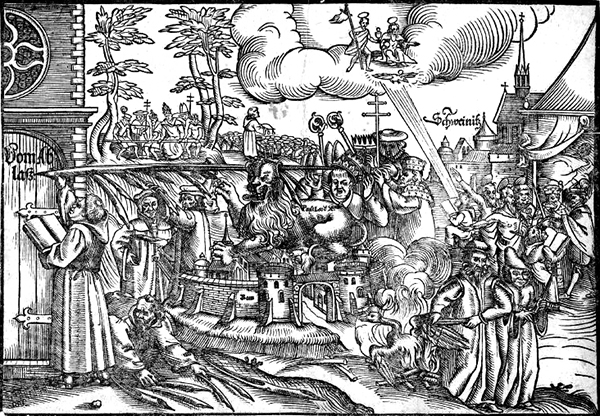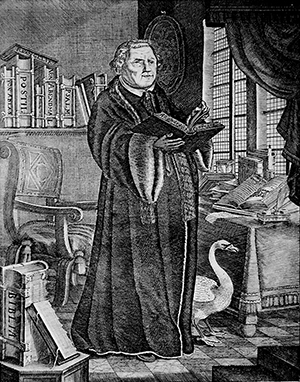History of the Reformation: The 95 Theses

Martin Luther inscribes the 95 Theses on the door of the Castle Church in Wittenberg. The end of his quill pen knocks off the hat of Pope Leo X. (1617 Reformation Jubilee broadside).
by Mathew Block
The day was July 6, 1415. The place was Constance, an imperial city in southern Germany. The Czech theologian Jan Huss had arrived here in early November to face charges of heresy. Despite the promise of safe conduct, he had been imprisoned only a few weeks later. On June 5 he was brought to trial. He was given no chance to defend himself; he was simply asked to recant. Now he stood a condemned man, the flames before him. “Jesus Christ, son of the living God, have mercy upon me,” he prayed fervently.
Tradition says he said something else that day: “You are now going to burn a goose,” he warned his executioners (“Huss” is Czech for “goose”). “But in a century you will have a swan which you can neither roast nor boil.”

The inclusion of a swan became a common motif in depictions of Luther after his death.
The words may just be legend but they are not for that reason any less prescient. A little more than 100 years after the death of Huss, Martin Luther would publish his 95 Theses—an event widely considered the beginning of the Reformation. Even Luther would come to see himself as the “swan” of which Huss reportedly prophesied.
In many ways, Huss was a forerunner for Martin Luther (and Huss himself was inspired by an even earlier reformer, the English theologian John Wycliffe). Huss and Wycliffe called for greater emphasis to be placed on reading and preaching the Scriptures. They both argued that the pope was fallible and to be resisted when he erred. And they both condemned the sale of indulgences.
These ideas would be adopted and expanded by Martin Luther, and he would bring even greater reforms to the church in the years to come, especially on the doctrine of justification. In 1517, however, “Lutheranism” was still in its infancy. With the publication of the 95 Theses, Luther became just the latest voice to protest abuses in the church.
He would quickly become the loudest. Luther’s 95 Theses set the world aflame with debate over the practice of indulgence selling. In the text, Luther rightly worries that the selling of indulgences impoverished common people without giving them the forgiveness they sought. “Those indulgence preachers are in error who say that a man is absolved from every penalty and saved by papal indulgences,” he writes. “They preach only human doctrines who say that as soon as the money clinks into the money chest, the soul flies out of purgatory.”
He goes on to note that the sale of indulgences also led the less pious to believe they could simply buy their way into heaven, without true penitence. Luther denied this strongly. “They who teach that contrition is not necessary on the part of those who intend to buy souls out of purgatory or to buy confessional privileges preach unchristian doctrine,” he writes. “Any truly repentant Christian has a right to full remission of penalty and guilt, even without indulgence letters.” In fact, for Luther, repentance—true repentance—was key to the Christian life. He writes in the very first thesis: “When our Lord and Master Jesus Christ said, ‘Repent’ (Matthew 4:17), he willed the entire life of believers to be one of repentance.”
In addition to confusing the theology of repentance and forgiveness, Luther also argued that the sale of indulgences had other effects too: they discouraged acts of mercy like alms-giving to the poor, as people spent their money instead on indulgences. And the emphasis on indulgences obscured proclamation of God’s Word. “Injury is done to the Word of God when, in the same sermon, an equal or larger amount of time is devoted to indulgences than to the Word,” Luther notes.
There are glimpses here of later Lutheran belief, but we should not overstate the importance of the 95 Theses. The document is hardly representative of Luther’s mature theology; he still accepts here, for example, the existence of purgatory. And Luther’s theology of salvation is underdeveloped; he does not yet understand the Gospel of salvation by free grace. Instead, he believes salvation to be dependent upon achieving a state of “true repentance” which, at this time, he equated with “hatred of self.” In other words, God was very angry at us for our sin; the only way to get into God’s good books was to agree with Him that we, are indeed very sinful and worthy of damnation—to hate ourselves just as much as God hates us. Consequently, Luther thought, we must embrace both “inner repentance” and “outward mortification of the flesh” to demonstrate this self-hatred.
Clearly lacking in this description of repentance and salvation is the mercy of Christ. That would come later.
Still, the publication of the 95 Theses was a pivotal moment in Reformation history. It brought Luther to the attention both of the common people in Germany, as well as the hierarchy of the church. The document quickly spread across Europe, generating great controversy as it did so. It did not help that Luther had questioned not only indulgences but also the pope’s own charity in promoting them. Posing it as a question from the laity, Luther asks: “Why does not the pope empty purgatory for the sake of holy love and the dire need of the souls there,” rather than “for the sake of miserable money with which to build a church?”
Within months, Pope Leo X would ask the head of Luther’s religious order to stop him from speaking about indulgences. Half a year later, Luther would be summoned to Rome (Frederick the Wise intervened, allowing Luther to be questioned in Augsburg by Cardinal Cajetan instead in October 1518). The theologian Johann Eck would begin a longstanding disagreement with Luther on the matter, which culminated in a public debate in Leipzig in July 1519.
There, Eck would accuse Luther of being a “Hussite”—a follower of Huss—and therefore a heretic. Luther countered that, perhaps, the council of Constance had been wrong in condemning Huss. Popes and councils could err, he suggested; but Scripture could not. Luther would later write: “We are all Hussites without having realized it.”
The swan was beginning to sing his song. And true to the words long attributed to Huss, no one would silence him.
———————
Mathew Block is communications manager of Lutheran Church–Canada and editor of The Canadian Lutheran magazine.
This is part one in a six-part series on the History of the Reformation. Find all the currently published articles here.





